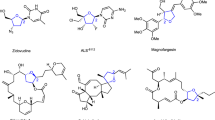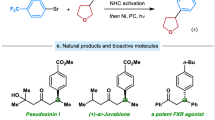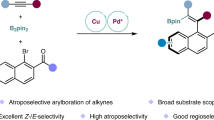Abstract
Enantioselective functionalization of alkenes is an attractive and straightforward method to assemble molecular complexity from readily available chemical feedstocks. Although regio- and enantioselective transformations of the C=C bond of alkenes have been extensively studied, those of the allylic C–H bonds of unactivated alkenes are yet to be explored. Here we report a palladium-catalysed branch- and enantioselective allylic C–H alkylation that is capable of accommodating diverse types of α-alkenes, ranging from feedstocks annually manufactured on a million-tonne scale to olefins tethering a wide scope of appended functionalities, providing unconventional access to chiral γ,δ-unsaturated amides. Notably, mechanistic studies reveal that regioselectivity is not only governed by the coordination pattern of nucleophiles but also regulated by the ligational behaviours of ligands, highlighting the importance of the monoligation of chiral phosphoramidite ligands in provoking high levels of stereo- and branch-selectivity via a nucleophile coordination-enabled inner-sphere allylation pathway.

This is a preview of subscription content, access via your institution
Access options
Subscribe to this journal
Receive 12 digital issues and online access to articles
$119.00 per year
only $9.92 per issue
Buy this article
- Purchase on Springer Link
- Instant access to full article PDF
Prices may be subject to local taxes which are calculated during checkout





Similar content being viewed by others
Data availability
All data generated or analysed during this study are included in this published article and its Supplementary Information. Crystallographic data for the structures reported in this article have been deposited at the Cambridge Crystallographic Data Centre, under deposition no. CCDC 2142298 (16). Copies of the data can be obtained free of charge via https://www.ccdc.cam.ac.uk/structures/.
References
Carruthers, W. & Coldham, I. in Modern Methods of Organic Synthesis (Cambridge Univ. Press, Cambridge, 2004).
Beller, M., Seayad, J., Tillack, A. & Jiao, H. Catalytic Markovnikov and anti-Markovnikov functionalization of alkenes and alkynes: recent developments and trends. Angew. Chem. Int. Ed. 43, 3368–3398 (2004).
Dong, Z., Ren, Z., Thompson, S. J., Xu, Y. & Dong, G. Transition-metal-catalyzed C–H alkylation using alkenes. Chem. Rev. 117, 9333–9403 (2017).
McDonald, R. I., Liu, G. & Stahl, S. S. Palladium(II)-catalyzed alkene functionalization via nucleopalladation: stereochemical pathways and enantioselective catalytic applications. Chem. Rev. 111, 2981–3019 (2011).
Newton, C. G., Wang, S. G., Oliveira, C. C. & Cramer, N. Catalytic enantioselective transformations involving C–H bond cleavage by transition-metal complexes. Chem. Rev. 117, 8908–8976 (2017).
Qin, Y., Zhu, L. & Luo, S. Organocatalysis in inert C–H bond functionalization. Chem. Rev. 117, 9433–9520 (2017).
Qi, X., Chen, P. & Liu, G. Advances and challenges in palladium-catalyzed intermolecular selective allylic C–H functionalization of alkenes. Sci. China Chem. 58, 1249–1251 (2015).
Andrus, M. B. & Zhou, Z. Highly enantioselective copper-bisoxazoline-catalyzed allylic oxidation of cyclic olefins with tert-butyl p-nitroperbenzoate. J. Am. Chem. Soc. 124, 8806–8807 (2002).
Li, J. et al. Site-specific allylic C–H bond functionalization with a copper-bound N-centred radical. Nature 574, 516–521 (2019).
Kubiak, R. W. II et al. Enantioselective intermolecular C–H functionalization of allylic and benzylic sp3 C–H bonds using N-sulfonyl-1,2,3-triazoles. Org. Lett. 18, 3118–3121 (2016).
Vaitla, J., Boni, Y. T. & Davies, H. M. L. Distal allylic/benzylic C–H Functionalization of silyl ethers using donor/acceptor rhodium(II) carbenes. Angew. Chem. Int. Ed. 59, 7397–7402 (2020).
Farr, C. M. B. et al. Designing a planar chiral rhodium indenyl catalyst for regio- and enantioselective allylic C–H amidation. J. Am. Chem. Soc. 142, 13996–14004 (2020).
Wang, P.-S. & Gong, L.-Z. Palladium-catalyzed asymmetric allylic C–H functionalization: mechanism, stereo- and regioselectivities, and synthetic applications. Acc. Chem. Res. 53, 2841–2854 (2020).
Ammann, S. E., Liu, W. & White, M. C. Enantioselective allylic C–H oxidation of terminal olefins to isochromans by palladium(II)/chiral sulfoxide catalysis. Angew. Chem. Int. Ed. 55, 9571–9575 (2016).
Liu, W., Ali, S. Z., Ammann, S. E. & White, M. C. Asymmetric allylic C–H alkylation via palladium(II)/cis-ArSOX catalysis. J. Am. Chem. Soc. 140, 10658–10662 (2018).
Teichert, J. F. & Feringa, B. L. Phosphoramidites: privileged ligands in asymmetric catalysis. Angew. Chem. Int. Ed. 49, 2486–2528 (2010).
Trost, B. M., Thaisrivongs, D. A. & Donckele, E. J. Palladium-catalyzed enantioselective allylic alkylations through C–H activation. Angew. Chem. Int. Ed. 52, 1523–1526 (2013).
Wang, P.-S. et al. Asymmetric allylic C–H oxidation for the synthesis of chromans. J. Am. Chem. Soc. 137, 12732–12735 (2015).
Lin, H.-C. et al. Nucleophile-dependent Z/E- and regioselectivity in the palladium-catalyzed asymmetric allylic C–H alkylation of 1,4-dienes. J. Am. Chem. Soc. 141, 5824–5834 (2019).
Trost, B. M., Machacek, M. R. & Aponick, A. Predicting the stereochemistry of diphenylphosphino benzoic acid (DPPBA)-based palladium-catalyzed asymmetric allylic alkylation reactions: a working model. Acc. Chem. Res. 39, 747–760 (2006).
Bai, D.-C. et al. Palladium/N-heterocyclic carbene catalysed regio and diastereoselective reaction of ketones with allyl reagents via inner-sphere mechanism. Nat. Commun. 7, 11806 (2016).
Cusumano, A. Q., Stoltz, B. M. & Goddard, W. A. III Reaction mechanism, origins of enantioselectivity, and reactivity trends in asymmetric allylic alkylation: a comprehensive quantum mechanics investigation of a C(sp3)–C(sp3) cross-coupling. J. Am. Chem. Soc. 142, 13917–13933 (2020).
Fan, L.-F. et al. Nucleophile coordination enabled regioselectivity in palladium-catalyzed asymmetric allylic C–H alkylation. Angew. Chem. Int. Ed. 58, 16806–16810 (2019).
Wang, T.-C., Fan, L.-F., Shen, Y., Wang, P.-S. & Gong, L.-Z. Asymmetric allylic C–H alkylation of allyl ethers with 2-acylimidazoles. J. Am. Chem. Soc. 141, 10616–10620 (2019).
Wang, T.-C., Wang, P.-S. & Gong, L.-Z. Palladium-catalyzed asymmetric allylic C–H alkylation of 1,4-dienes and glycine Schiff bases. Sci. China Chem. 63, 454–459 (2020).
Dai, Z.-Y., Wang, P.-S. & Gong, L.-Z. Access to chiral gamma-butenolides via palladium-catalyzed asymmetric allylic C–H alkylation of 1,4-dienes. Chem. Commun. 57, 6748–6751 (2021).
Lin, H.-C. et al. Highly enantioselective allylic C–H alkylation of terminal olefins with pyrazol-5-ones enabled by cooperative catalysis of palladium complex and Bronsted acid. J. Am. Chem. Soc. 138, 14354–14361 (2016).
Qin, L., Sharique, M. & Tambar, U. K. Controllable, sequential, and stereoselective C–H allylic alkylation of alkenes. J. Am. Chem. Soc. 141, 17305–17313 (2019).
Lin, S., Song, C.-X., Cai, G.-X., Wang, W.-H. & Shi, Z.-J. Intra/intermolecular direct allylic alkylation via Pd(II)-catalyzed allylic C–H activation. J. Am. Chem. Soc. 130, 12901–129003 (2008).
Young, A. J. & White, M. C. Catalytic intermolecular allylic C–H alkylation. J. Am. Chem. Soc. 130, 14090–14091 (2008).
Sharma, A. & Hartwig, J. F. Enantioselective functionalization of allylic C–H bonds following a strategy of functionalization and diversification. J. Am. Chem. Soc. 135, 17983–17989 (2013).
Pan, S. et al. Palladium-catalyzed allylic substitution reaction of benzothiazolylacetamide with allylic alcohols in water. J. Org. Chem. 84, 10111–10119 (2019).
Franck, G., Brodner, K. & Helmchen, G. Enantioselective modular synthesis of cyclohexenones: total syntheses of (+)-crypto- and (+)-infectocaryone. Org. Lett. 12, 3886–3889 (2010).
Helmchen, G., Gnamm, C., Förster, S., Miller, N. & Brödner, K. Enantioselective iridium-catalyzed allylic alkylations—improvements and applications based on salt-free reaction conditions. Synlett 2007, 0790–0794 (2007).
Saito, A., Kogure, N., Kitajima, M. & Takayama, H. Total synthesis of (-)-14-hydroxygelsenicine and six biogenetically related gelsemium alkaloids. Org. Lett. 21, 7134–7137 (2019).
Stork, G. et al. The first stereoselective total synthesis of quinine. J. Am. Chem. Soc. 123, 3239–3242 (2001).
Ito, H. et al. Enantioselective total synthesis of both diastereomers of preclavulone-A methyl ester. Tetrahedron 62, 10425–10433 (2006).
Trost, B. M. & Vranken, Van, D. L. Asymmetric transition metal-catalyzed allylic alkylations. Chem. Rev. 96, 395–422 (1996).
Pamies, O. et al. Recent advances in enantioselective Pd-catalyzed allylic substitution: from design to applications. Chem. Rev. 121, 4373–4505 (2021).
Zhang, Z.-F., Xie, F., Yang, B., Yu, H. & Zhang, W.-B. Chiral phosphoramidite ligand and Its application in asymmetric catalysis. Chin. J. Org. Chem. 31, 429–442 (2011).
Boele, M. D. et al. Bulky monodentate phosphoramidites in palladium-catalyzed allylic alkylation reactions: aspects of regioselectivity and enantioselectivity. Chem. Eur. J. 10, 6232–6246 (2004).
van Leeuwen, P. W., Kamer, P. C., Reek, J. N. & Dierkes, P. Ligand bite angle effects in metal-catalyzed C–C bond formation. Chem. Rev. 100, 2741–2770 (2000).
Ogasawara, M., Takizawa, K.-i & Hayashi, T. Effects of bidentate phosphine ligands on syn−anti isomerization in π-allylpalladium complexes. Organometallics 21, 4853–4861 (2002).
Amatore, C., Jutand, A., Mensah, L. & Ricard, L. On the formation of Pd(II) complexes of Trost modular ligand involving N–H activation or P,O coordination in Pd-catalyzed allylic alkylations. J. Organomet. Chem. 692, 1457–1464 (2007).
Behenna, D. C. & Stoltz, B. M. The enantioselective Tsuji allylation. J. Am. Chem. Soc. 126, 15044–15045 (2004).
Young, C. M. et al. The importance of 1,5-oxygen···chalcogen interactions in enantioselective isochalcogenourea catalysis. Angew. Chem. Int. Ed. 59, 3705–3710 (2020).
Acknowledgements
We gratefully acknowledge the financial support from the NSFC (grant nos. 22188101), Youth Innovation Promotion Association CAS and Anhui Provincial Natural Science Foundation (grant no. 2108085MB58).
Author information
Authors and Affiliations
Contributions
Z.-S.N., P.-S.W. and L.-Z.G. conceived the project. Z.-S.N., T.-C.W. and L.-F.F. performed the experiments and analysed the data. L.Z. and P.-S.W. designed and performed the DFT calculations. P.-S.W. and L.-Z.G. supervised the research and co-wrote the manuscript.
Corresponding authors
Ethics declarations
Competing interests
The authors declare no competing interests.
Peer review
Peer review information
Nature Synthesis thanks Per-Ola Norrby and the other, anonymous, reviewer(s) for their contribution to the peer review of this work. Primary Handling editor: Thomas West, in collaboration with the Nature Synthesis team.
Additional information
Publisher’s note Springer Nature remains neutral with regard to jurisdictional claims in published maps and institutional affiliations.
Supplementary information
Supplementary Information
Supplementary Figs. 1–20, Discussion, NMR spectra, HPLC data, references and Tables 1–12.
Supplementary Data 1
Computational data
Supplementary Data 2
Crystallographic data for compound 16 CCDC 2142298
Rights and permissions
About this article
Cite this article
Nong, ZS., Zhu, L., Wang, TC. et al. Palladium-catalysed branch- and enantioselective allylic C–H alkylation of α-alkenes. Nat. Synth 1, 487–496 (2022). https://doi.org/10.1038/s44160-022-00084-7
Received:
Accepted:
Published:
Issue Date:
DOI: https://doi.org/10.1038/s44160-022-00084-7



